I have used Amazon affiliate links on this page. As an Amazon Associate, I earn a commission from qualifying purchases at no added cost to you. Thank you!

Table of Contents
Introduction

Polar blue parrot cichlid is also known as polar blue cichlid or polar parrot cichlid. They are thought to be a hybrid made by mixing the Convict cichlid and parrot cichlid. A lot of online sources support this theory. But there’s no actual evidence that these fish have been made as a hybrid, even if it’s true then there’s no scientific or documented evidence supporting that they were a product of cross-breeding the convicts and parrot cichlids. So we must keep an open mind about the origin of polar blue cichlids. However, the appearance of this fish does somewhat supports the theory of the convict and parrot cichlid hybrid.
There are a lot of online sources that claim that these fish get as long as 8 inches. This claim seems to be supported by the red parrot cichlid and convict cichlid hybrid theory. As they are claiming that the fish can get bigger like their parents, referring to the red parrot cichlids. But we have yet to see such big polar blue Cichlids in actual aquariums. A lot of fish we have personally seen, raised, and bred are a lot smaller. They barely reach half of the length of a grown blood parrot cichlid. The biggest polar blue parrots I have ever seen are about 3.5 inches to 4 inches long.
Anyhow, it’s one of the cutest and most popular cichlids in the market today. It’s hardy, easy to maintain fish, which we recommend for the newbies to the hobby. And they are also very easy to breed, so you may learn a lot by having them as pet fish and earn a side income by selling some of them to your friends!
The true identity of Polar Blue Parrot Cichlid
A dig into the polar blue cichlid subject has taken us a lot closer to this fish’s true identity. Certainly, It doesn’t seem to have any parrot cichlid genes in polar blue parrot cichlids. Instead, they are more likely a short-bodied strain of a convict cichlid. Or a short-bodied Honduran redpoint. Certainly, the breeders have been exploiting the short body deformity of these two fish breeds to create polar parrot cichlids. Or else, they probably have been cross-breeding convicts and Honduran red points and selective breeding them to exploit resulting short-body deformity. And finally came up with the so-called “polar blue parrot cichlid” strain around the 2000s.
When it comes to keeping this species as a pet or for breeding purposes, it’s all about getting quality information as quickly and easily as possible. So we worked hard to provide everything you need in one place to learn about how to keep a Polar Parrot Cichlid fish happy and healthy, including care tips, tank size requirements, main diet, breeding, etc.
The origin
We can trace back the origin of this fish back to the early 2000s. That’s when this breed started to appear in the market. There are lots of theories about how and where they first originated. There are claims that they first appeared in Taiwan. Somehow now they are popular all over the world among cichlid hobbyists. As we mentioned above, a lot of experts will tell you about red blood parrots being in their genes, but we aren’t so sure.
Apperarnce of full grown polar blue parrot cichlid
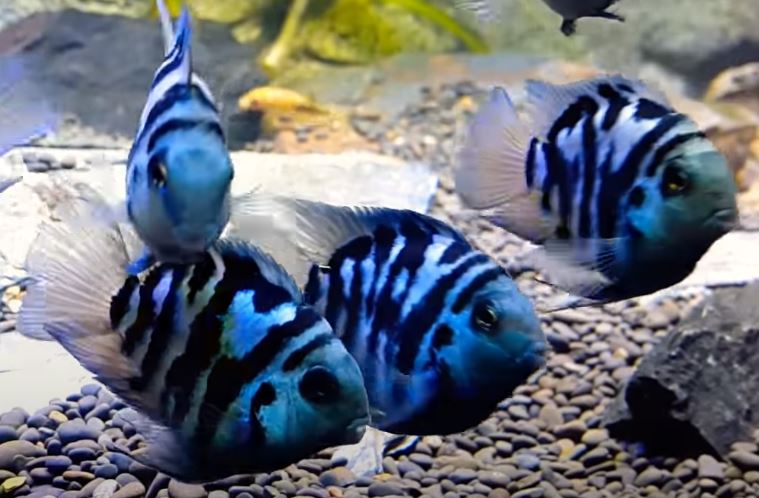
This fish has a head shape similar to the Blood Parrot, but with the body of a convict cichlid. This is why it’s called a parrot cichlid. But the appearance isn’t proof that they have been made by cross-breeding a blood parrot cichlid and a convict cichlid.
The body of this fish is rounded with a protruding mouth. The base color of this fish is white. So where is the red color inherited from a parrot cichlid?? On top of the white background, polar cichlid has black stripes through its body similar to the convict cichlids, but it grows on average up to 3.5 and 4 inches. They have a very compact and short body shape making them some of the cutest little cichlids.
Since you love Cichlids make sure to check the article about the amazing Red Empress Cichlid.
Availability of the Polar Cichlid
Recently the demand for this cute fish has been increased a lot, making the breeders produce the fish in massive numbers. So now they are being found in every major fish aquarium in USA and all around the world. On top of that, local fish breeders and hobbyists have started to breed the fish locally. It’s a very easy fish to be bred and taken care of. So there’s good news for us about the continued availability of the polar parrot cichlid.
Polar Blue Parrot Cichlid Male & Female
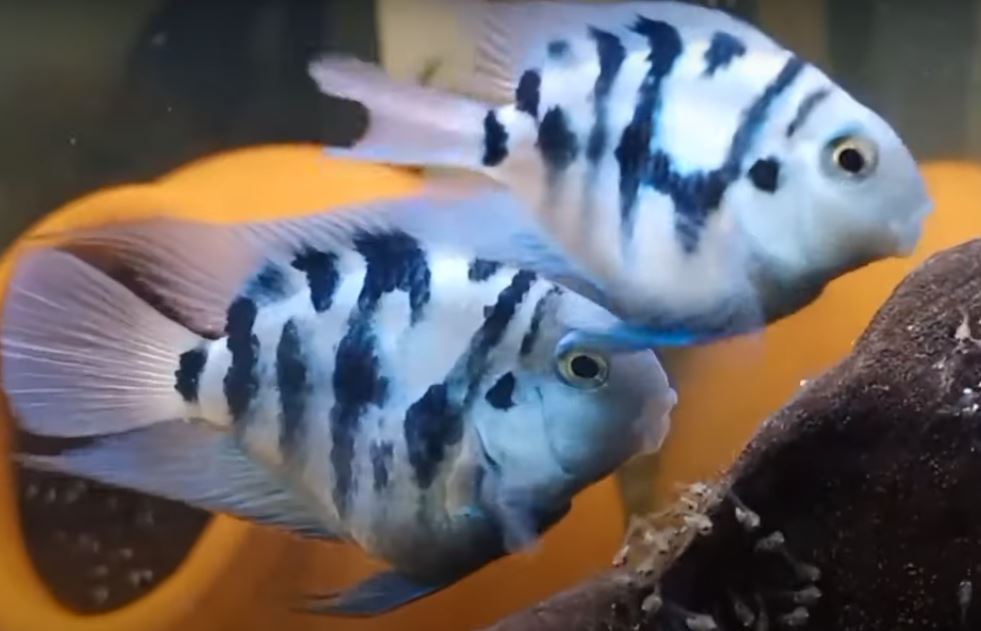
This fish can be easily sexed and bred. In their juvenile stage, they look almost the same, but can easily be sexed once they reach maturity. Male Polar Parrots have sharper and longer fins. The male Parrot Cichlid is usually thinner and has a broader body. On the other hand, the females, have a fatter body and they are usually smaller than the males. When they are sexually matured, the males have somewhat red tails, while the females have bluish tails. When the female becomes full of eggs ready to mate, its tummy color may turn bright yellow or orange. To fully confirm which one is male and which one is female you may wait until they start the mating ritual and until the female lays eggs.
Temperament and tank mates of Polar Parrot Cichlid
Polar parrot cichlids are very peaceful fish until they start breeding. Like any of the cichlid species, they become aggressive towards other tank mates when they start their mating rituals. From that on until their fry becomes larger enough to defend themselves the parents will guard the eggs and te\he fry aggressively. So it’s better to remove other fish of the same size and smaller than these fish. Apart from the mating season, they are relatively calm fish that will occupy almost any layer of the aquarium. And they won’t chase others away unless they really have to. And these cichlids won’t nip other fish, so I would say it’s a good community fish to put with other cichlid species around their size. You could keep completely different fish species like angelfish, plecos with the Polar Parrot.
It’s a Beginner’s Fish!
Polar blue cichlids are very beginner-friendly as they are very easy to take care of. They are very hardy and can adjust and fit into changing water conditions compare to other fish species. (This does not mean that you are free to let your water parameters go wild!)
The people new to the hobby get frustrated when their fish die, and they leave the hobby never to come back. Starting with a hardy fish like a blue parrot cichlid, minimizes such rick as these fish require minimal care. They thrive under basic requirements like basic filtration, space, and food. And there’s a lot that can be learned about fish keeping through a journey with a polar parrot cichlid.
How much space does a Polar Parrot Cichlid need?
Even the hardier fish get stressed and diseases when they are cramped into tiny spaces. On the other hand, a bigger tank is more capable of cycling the ammonia resulting from fish waste and food residuals. So, enough water volume is a key factor to successful fish keeping, regardless of the fish species.
You could easily keep a pair of Polar Cichlids in a 30-gallon tank. Every additional cichlid will require 10 more gallons in order to live healthily and happily.
The design of the tank
Hiding places
Cichlids love hiding caves so do polar parrot cichlids. Make sure to check out these nice little hiding ornaments and caves for your polar cichlid tank. These may be useful when they start to breed as well.
Substrate
The substrate in the aquarium helps the overall look and adds an extra layer for beneficial bacteria to grow. But make sure not to include gravel with sharp edges. The polar blue parrot cichlid is a gravel digger, hence it might hurt its mouth in the process. It’s better to use a sandy bottom.
Plants Vs Polar Parrot Cichlid
These cichlids won’t eat plants, but they are diggers so they might disrupt delicate plants like carpet plants. Hence these fish are a good fit for semi-planted aquariums as well.
Optimal Water Parameters
Water Temperatures
76°F to 82°F
Tolerable PH Range
6.4 to 7.5
The hardness of the Water
2 to 25 dGH
Filteration and Waterflow
There should be an average water filtration mechanism for your parrot cichlid tank. Although they can withstand some bad water qualities, prolonged bad water quality may eventually result in stress and diseases, hence must be avoided at all costs. Frequent water changes are advised for any kind of aquarium including cichlid tanks. You may do a 20% to 30% water change every week.
These fish aren’t strong swimmers hence they do not have a strong fin profile. So it’s wise not to use a strong water flow inside your aquarium.
What to feed your Polar Parrot?
These fish have a shorter digestive system, hence we shouldn’t overfeed them. And we should also make sure to feed them something easy to digest. Live foods aren’t recommended as they can cause bloat in these fish. Below are some of the recommended food for Polar Blue Parrot Cichlid.
Northfin Cichlid formula Pellet
Hikari Biogold Cichlid Pellets
The medium size:
Mini size
Polar Blue Parrot Cichlid Breeding
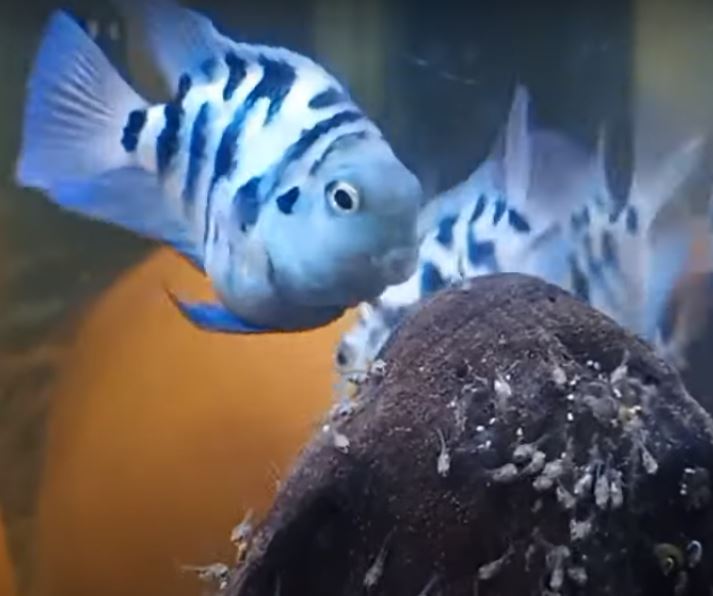
Breeding of this fish is very easy. They tend to breed every three months and the breeding process is similar to convict cichlids. If you have bred the convicts before then you can do the same with polar parrots as well.
First, you must separate the breeding couple into a separate breeding tank and start the feeding pair. They could even breed in a community tank but then the rest of the process becomes harder for the parents to take care of their fries from the tank mates trying to eat them.
How to prepare the breeding tank
The breeding tank shouldn’t be very large, since it may distract a couple from attracting to each other. Tanks starting from 30 gallons of volume to 75 gallons will work with no issue. First, you must introduce the pair into the breeding tank and let them become comfortable in their new environment. They should be spooked or get stressed or else they will completely forget about mating…
There should be something with a smooth surface for them to use as their breeding ground. Many breeders use a pot with a smooth surface and that works every time and perfectly. You may encourage the breeding by doing frequent water changes, but you must be aware not to spook the couple.
Mating and fertilizing the eggs
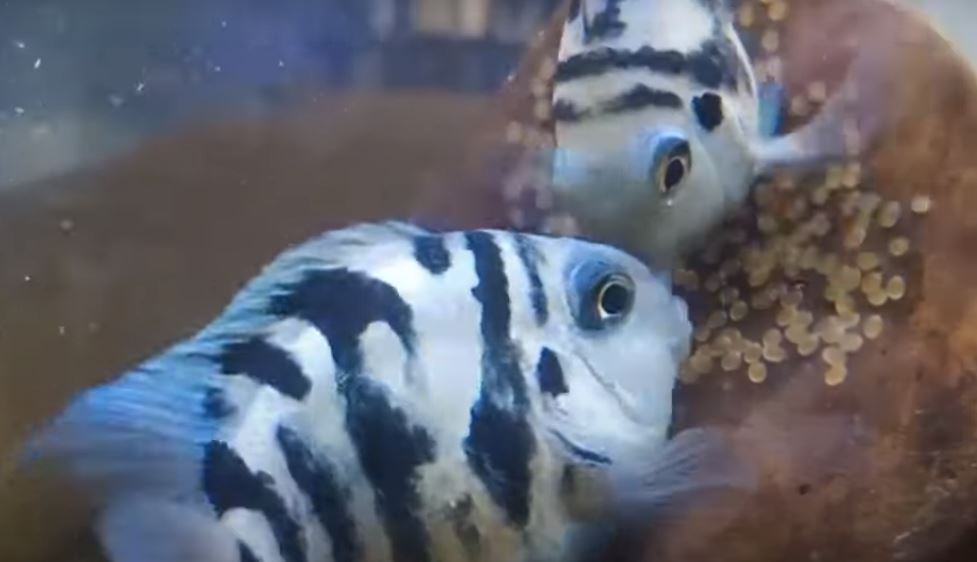
Once they get used to their romantic environment (set by us) the male starts going after the female and brings her to the mating pot. After the mating ritual, the female often lays eggs on the inner surface of the pot and the male comes to fertilize it.
The female can lay eggs up to around 300. They are transparent. The ones which get successfully fertilized by the male turns into a darker color and others will turn white. The fertilization can take up to 12 hours. Both parents will use their fins to clean and provide oxygen to the eggs. You can add a few drops of methylene blue to the tank to protect the eggs from fungus and support the parents in their endeavors.
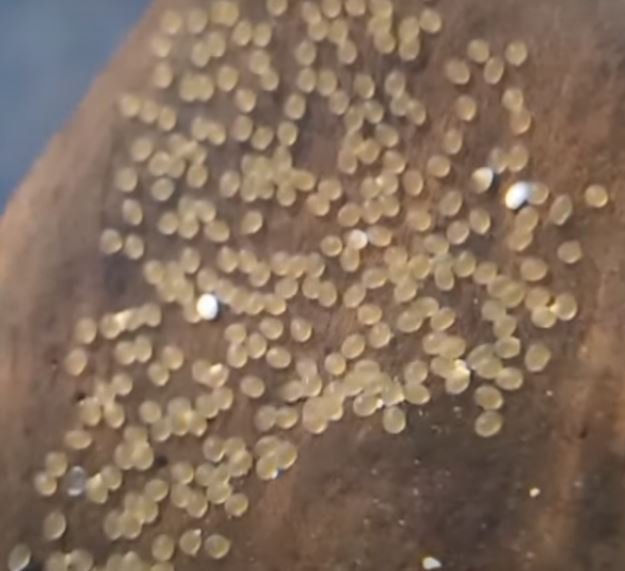
Polar blue parrot cichlid fry
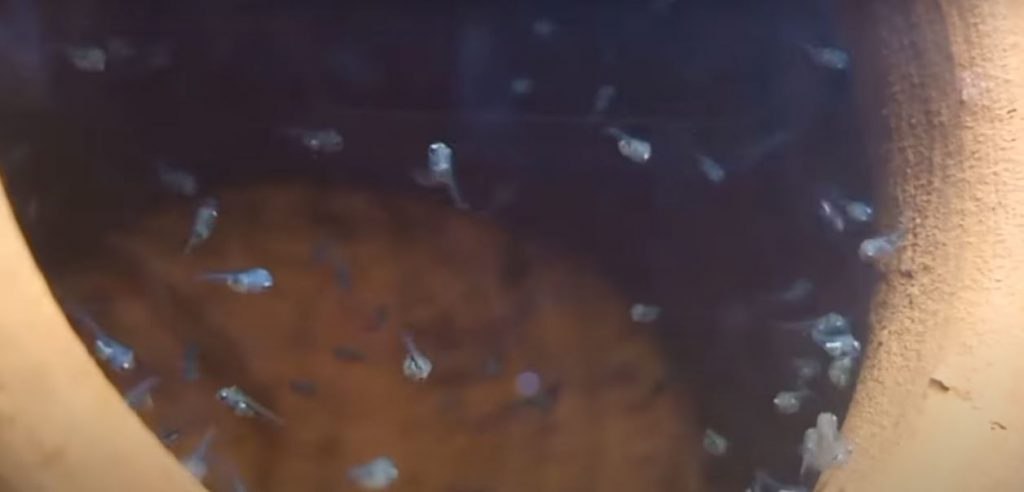
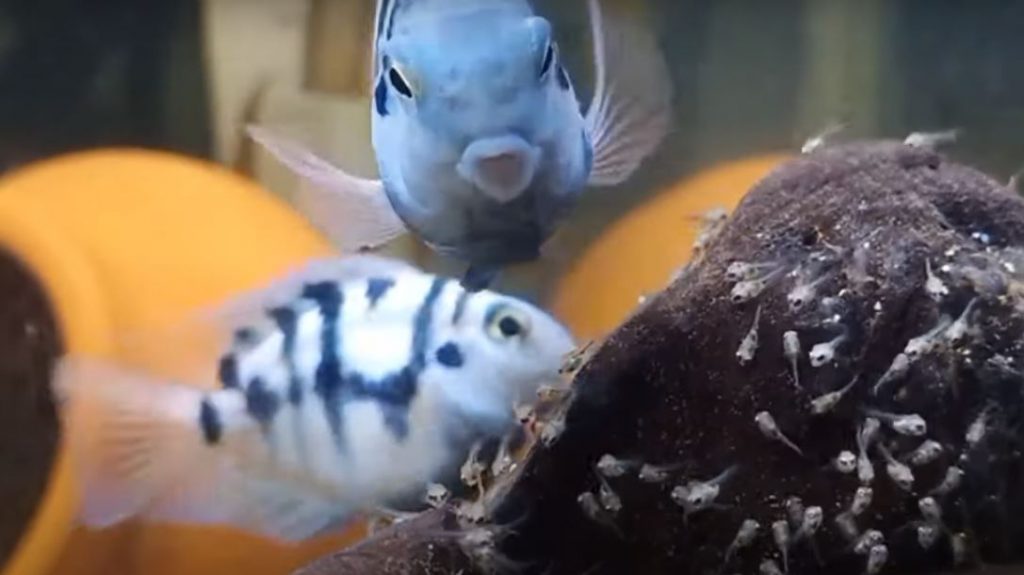
It takes around two days to hatch the eggs. The polar blue parrot cichlid fry will stay together and around their parents for protection. The parents will guard their young aggressively just like they protected the eggs until the fry is big enough to defend themselves.
What to feed your polar blue parrot cichlid fry?
You can start giving hatched brine shrimp to the blue parrot cichlid fry once they have used their yolk sack.
Order baby Brine Shrimp online:
When they are a bit grown you can start giving some good pellets made for the fish fry. There should be a transition period for the fry to get used to fry pellets, so make sure to feed both artemias (brine shrimp) and fry pellets in this period until you stop giving brine shrimp to them completely.
Below flake pellets are best for polar blue parrot cichlid fry. So make sure to check them out. And do remember not to put more than the fry needs to eat as these foods can change the water chemistry quickly.
Tetra Cichlid Balanced diet flake food:
Northfin Cichlid formula pellet:
Desease of blue parrot cichlid
The good news is that the polar blue parrot cichlid is a hardy fish that has good resistance to diseases. But even the strongest fish can get diseases if we aren’t being careful of water parameters, hence the water quality. If there’s good water quality, enough spaces and provided there’s a quarantine tank for newcomers, then there’s a good chance you won’t have to worry about the diseases of this fish.
Ich (ichthyophthirius multifiliis) in Polar Blue Parrot Cichlid
Ich, or ichthyophthirius multifiliis, is the single most common parasite that can attack fish. It is an external parasite that is visible to the naked eye. It appears as white spots on the skin, fins, and even gills of fish. The spots appear circular and look like grains of salt. Ich causes discomfort to the host during its advanced stages as they begin to irritate the fish.
The disease can be identified by the white dots covering the body of your fish. If left untreated, it can spread to other fish in your tank! It’s easy to treat; in fact, raising the temperature slightly and using a copper-based treatment should do the trick.
While doing the treatment make sure to change water frequently (without harming the water parameters) to eliminate the free-swimming stage of the ich parasite from your aquarium.
And the next time, please make sure to maintain good water quality and don’t let the water temperature go below the required marking. And most importantly quarantine any new fish before introducing them to your polar blue parrot cichlid tank.
Bloat
Bloat is a problem that many fish owners have encountered at one time or another. This common issue is caused by the inability of the digestive system to keep up with the amount of food provided. When a fish eats a lot of food faster than it can digest, then gets more food, it can’t process all of its food in time, which causes excess water in the stomach.
When fish have shorter bodies like in the case of Polar Blue Parrot Cichlid, they tend to have shorter digestive systems. So they have trouble digesting food. With live foods, bloating can be quite common. It’s important to feed fish slow-release food with plenty of fiber and to offer them plenty of space for swimming so they can exercise and help move their food through their digestive system.
If your cichlid has bloat then make the,m fast for a couple of days, it should give enough time for the fish to digest the food. Then give it a boiled pea. make sure to remove the shell though. It will help the fish to digest food fast. And the next time, don’t overfeed the fish and consider giving less live food.
Summery and Conclusion
Polar Blue Parrot Cichlid is a great beginner’s fish that rarely gets diseases. It requires minimum maintenance and is easy to breed. No one’s so sure about how they were made by breeders, but as we are writing this their popularity seems to skyrocket. It is indeed a cute fish with a compact body. They can be kept in groups of their own kind and with other similar cichlids like convicts. They have a mild temperament towards other fish, but given enough space, they will be as peaceful as they can be. So be sure to check them out when you visit your local aquarium shop next time.

Pingback: True Parrot Cichlid (Hoplarchus Psittacus) - Pet Fish 101
Pingback: How Long Do Angelfish Live? Improving Their Lifespan - Pet Fish 101